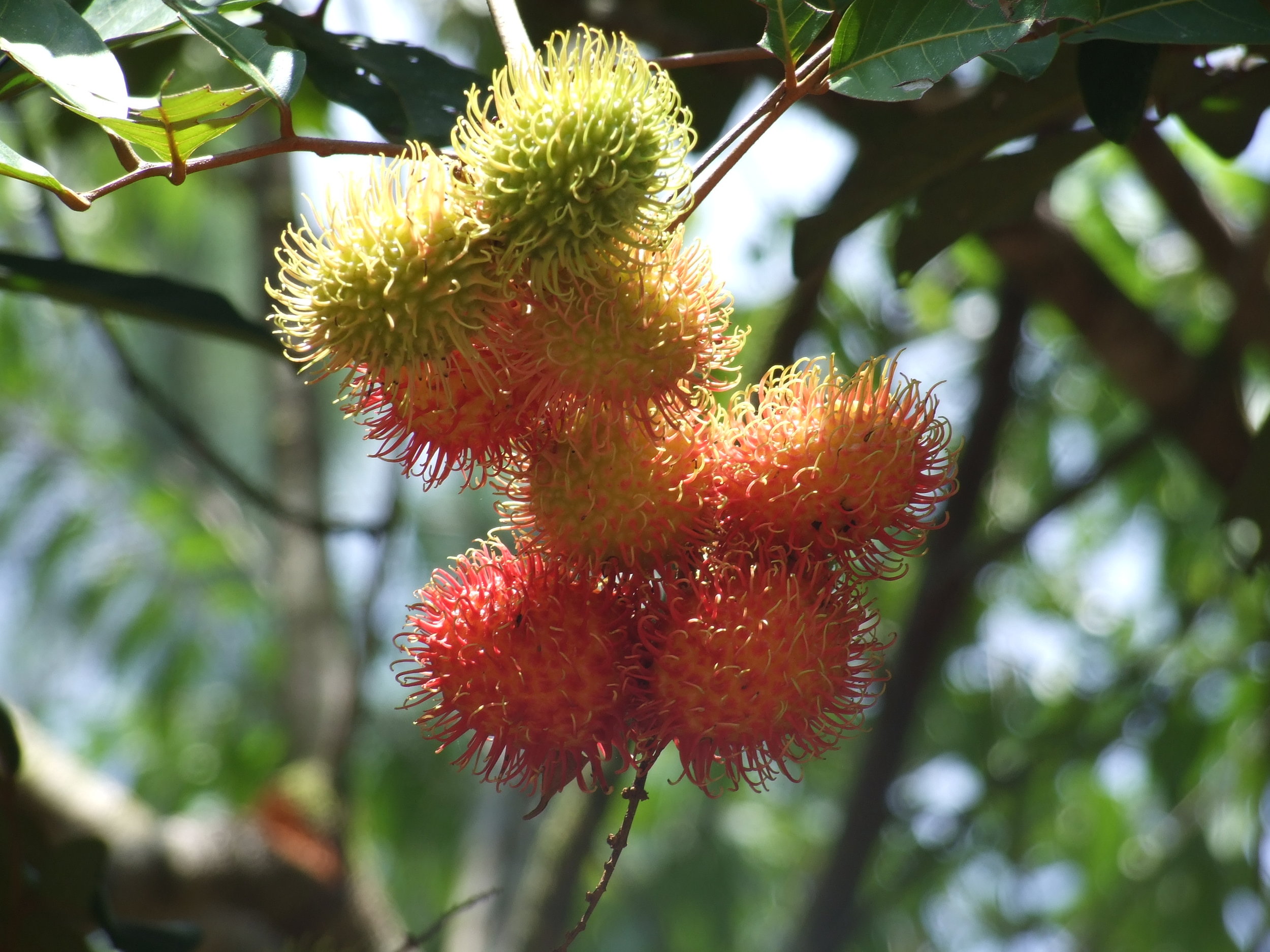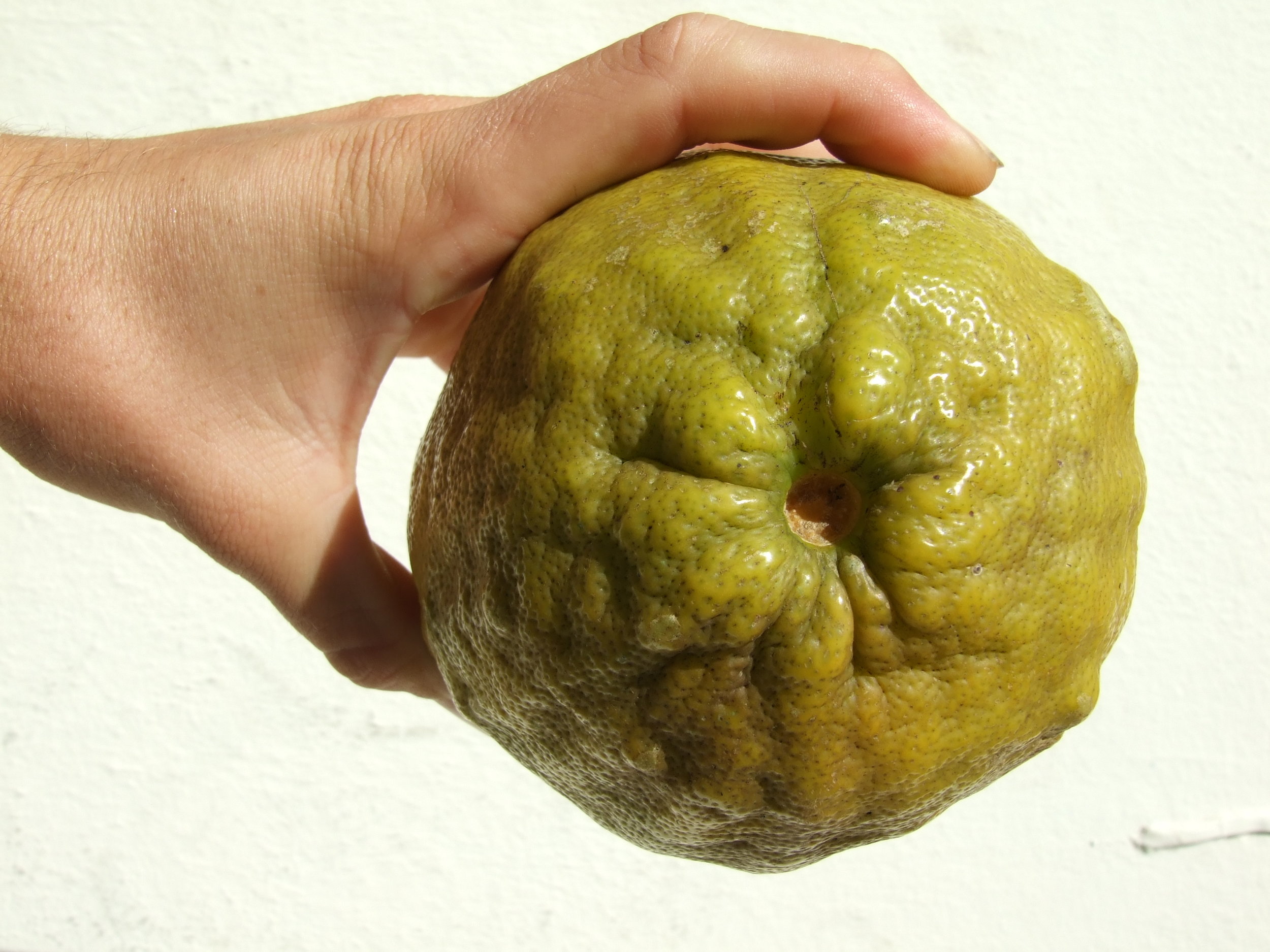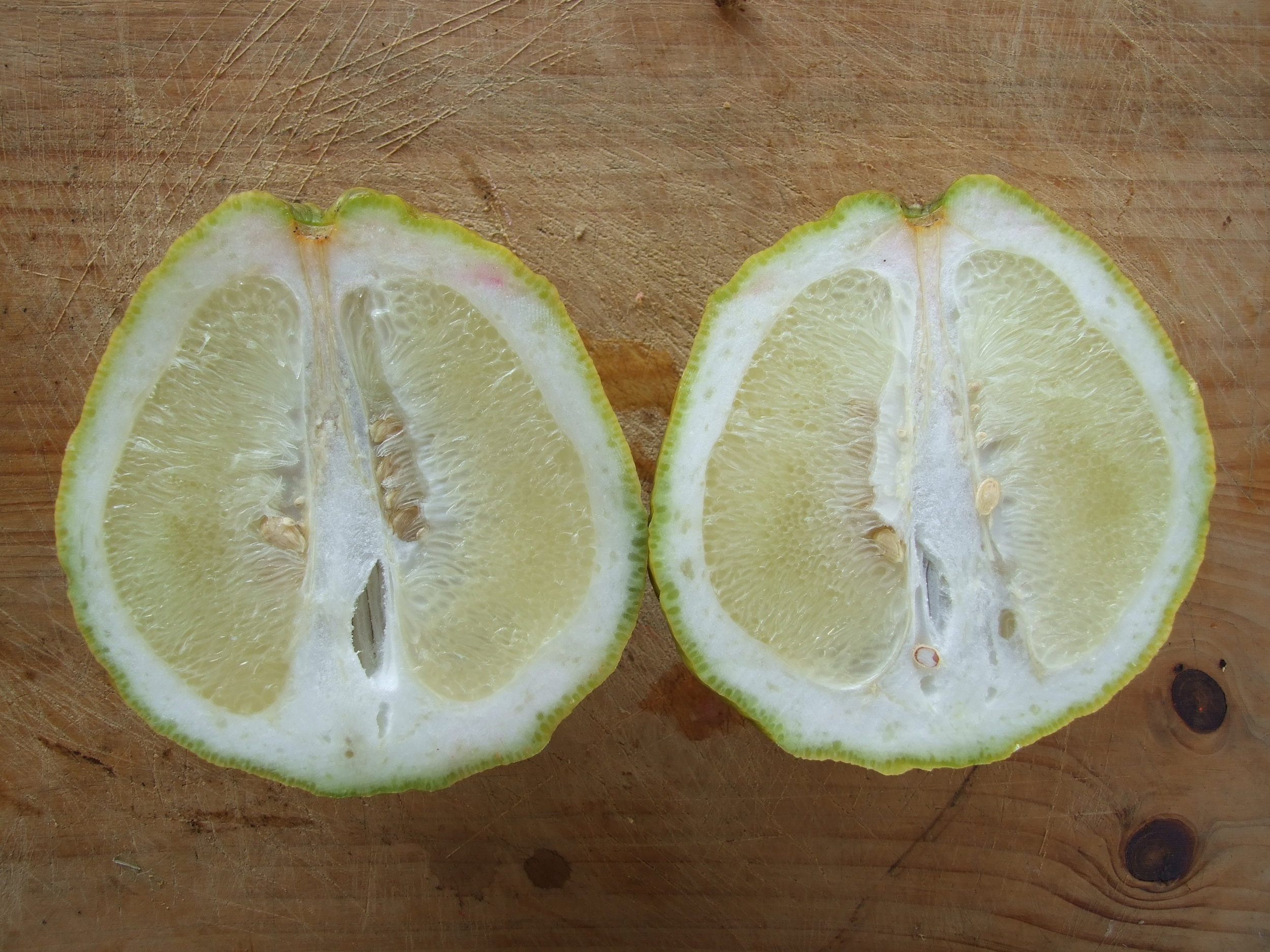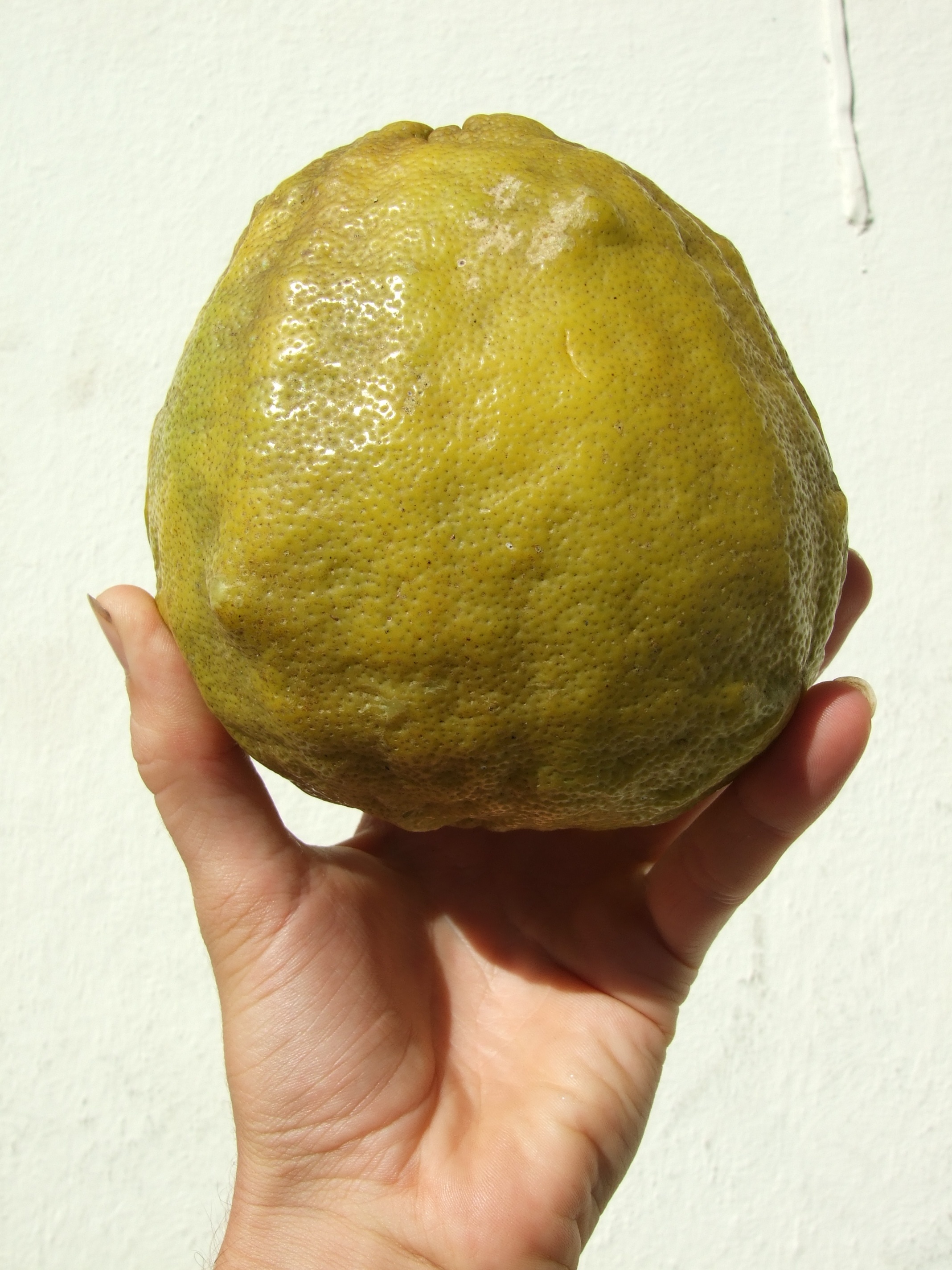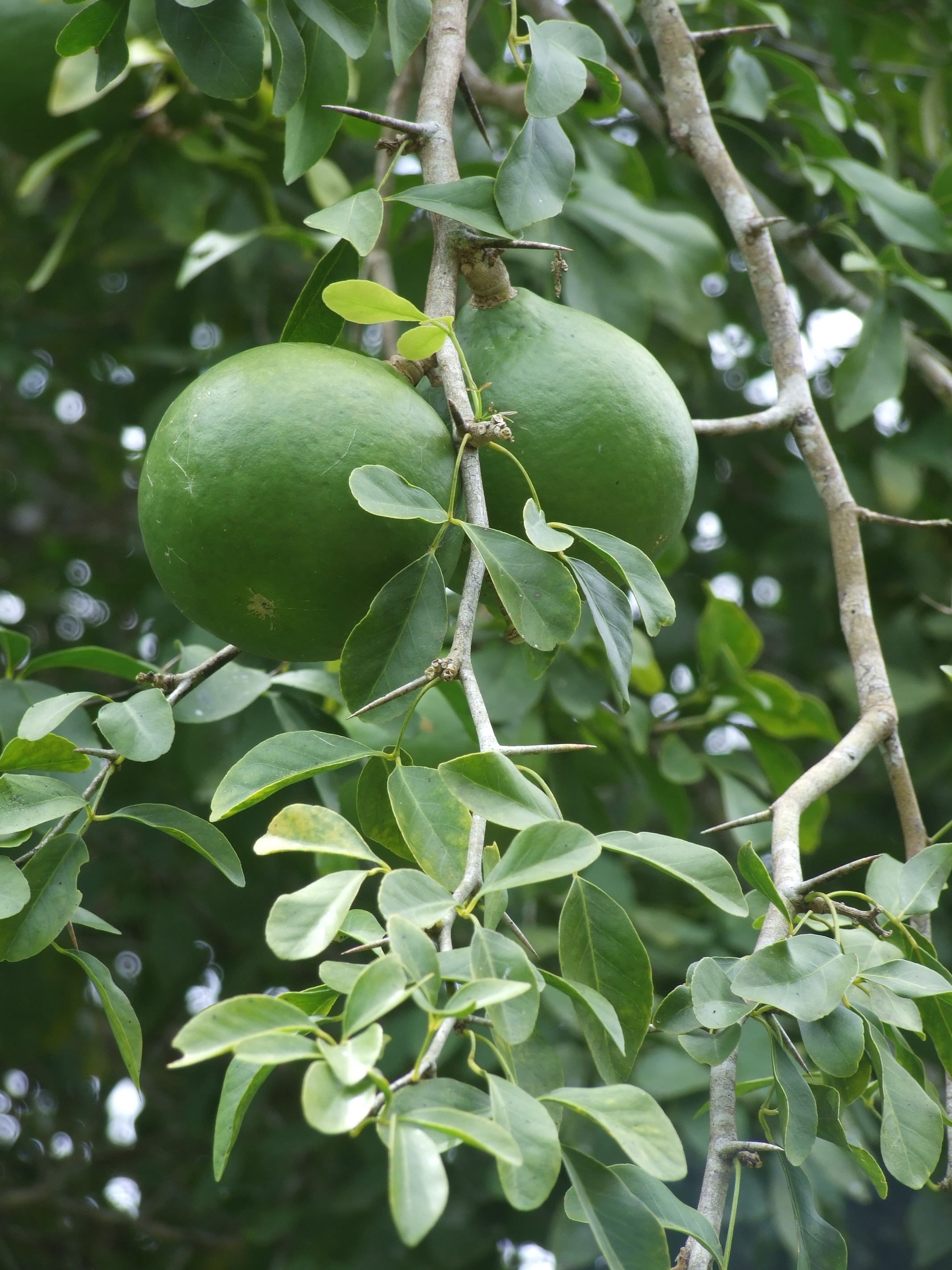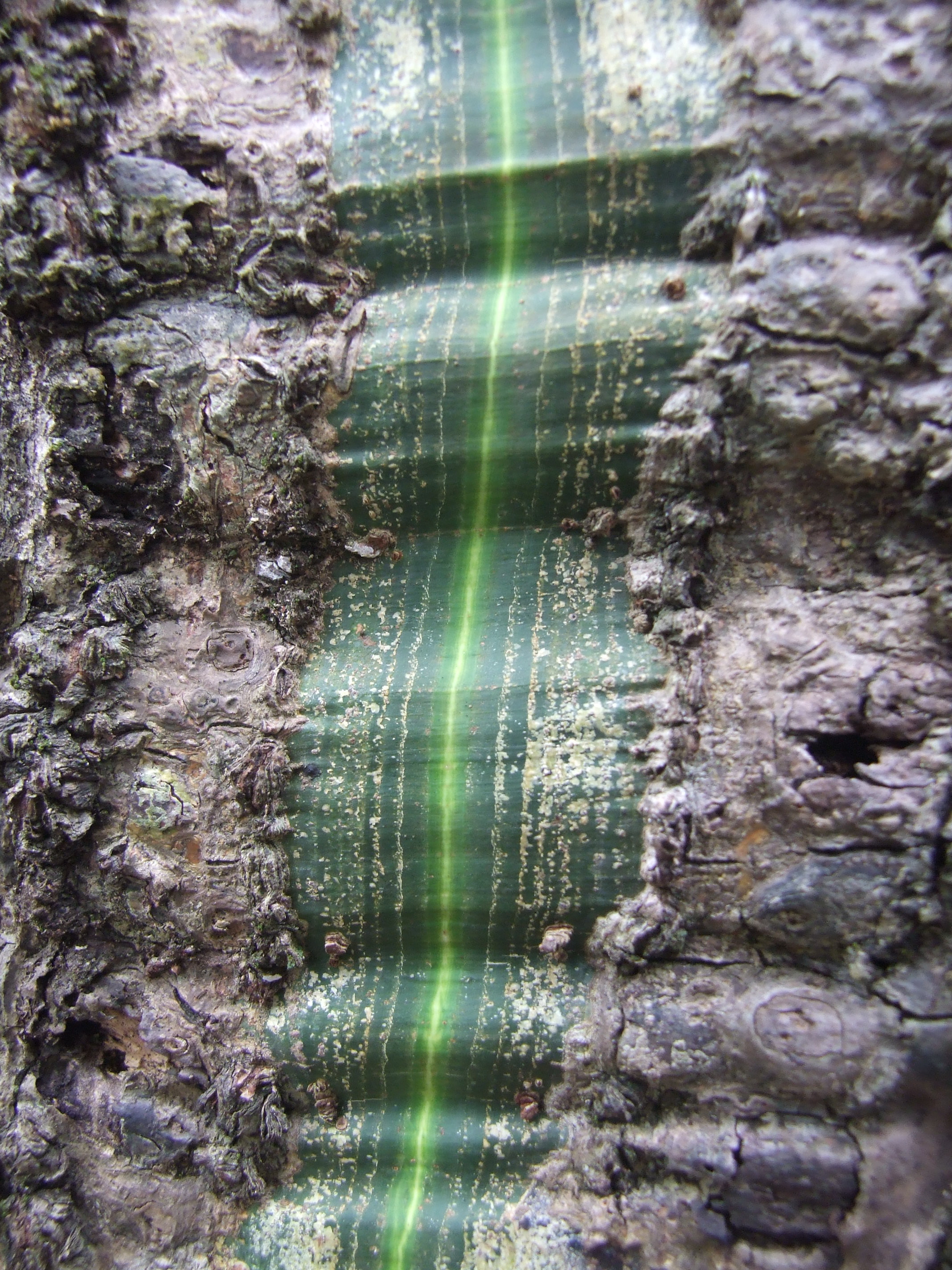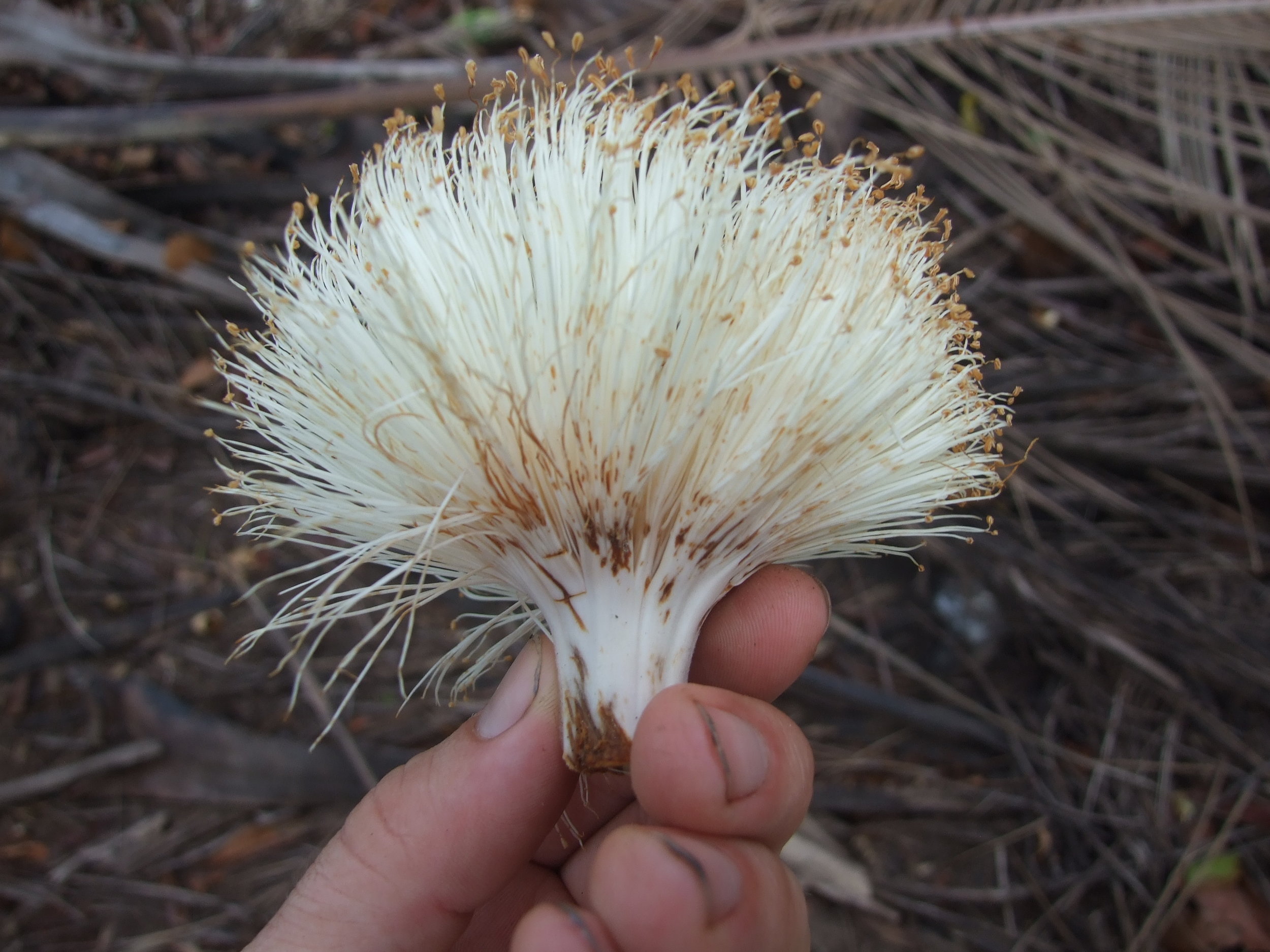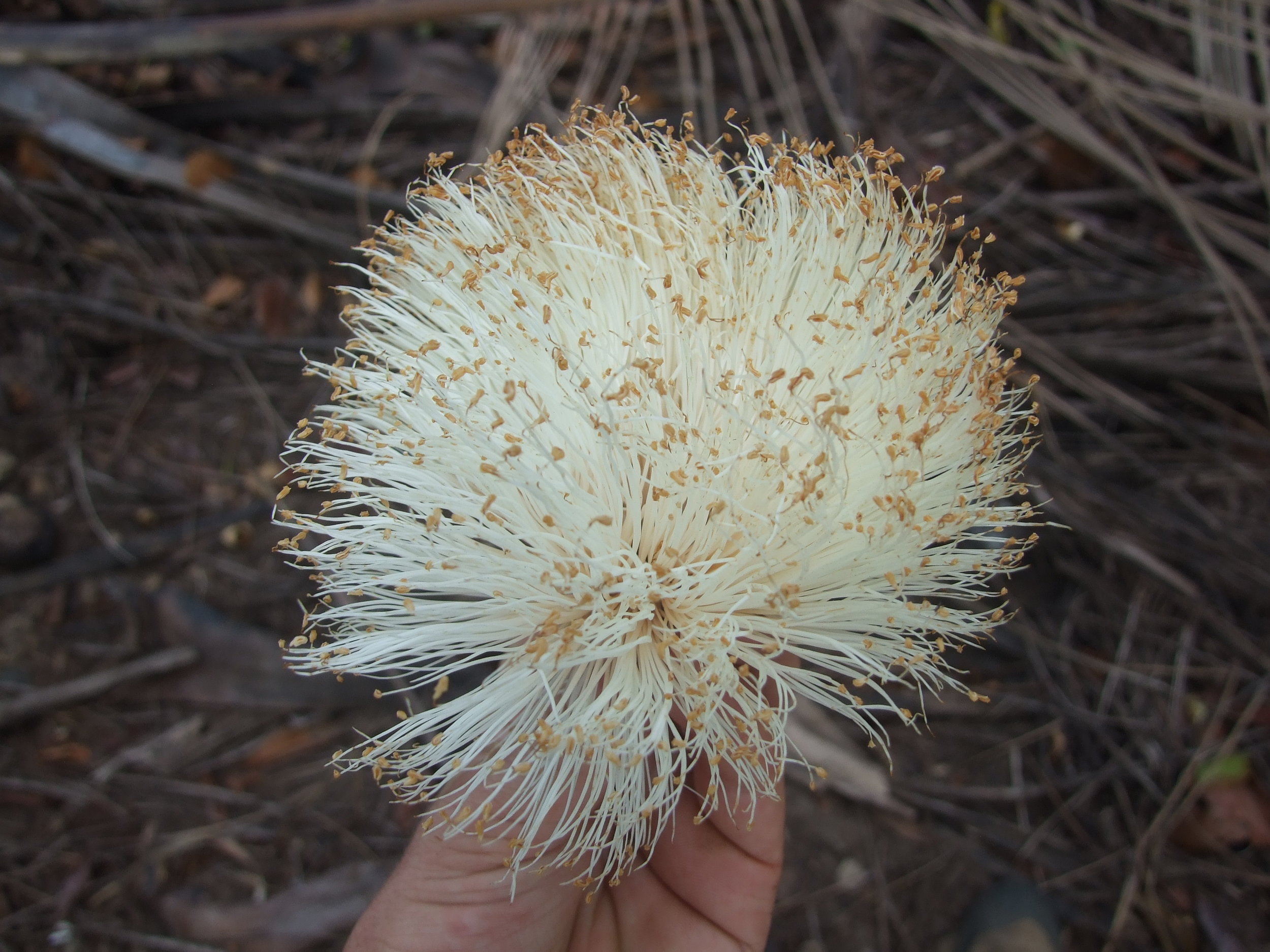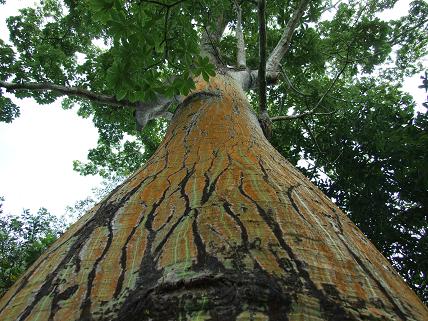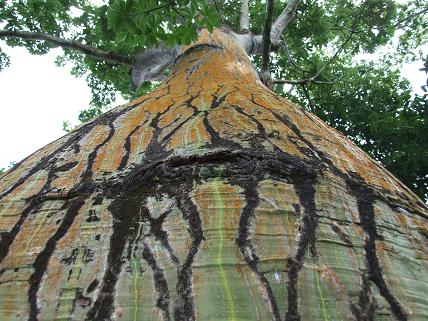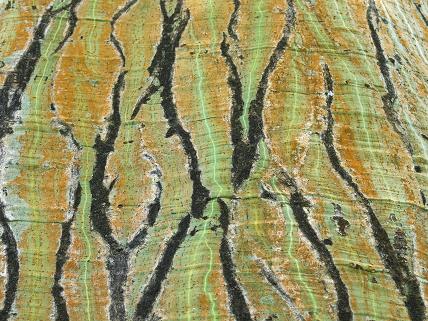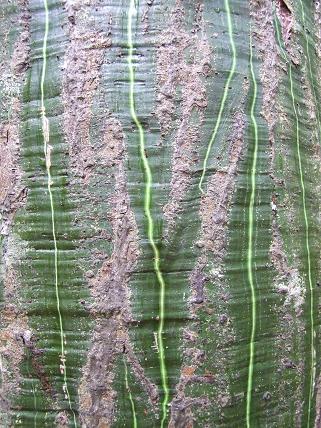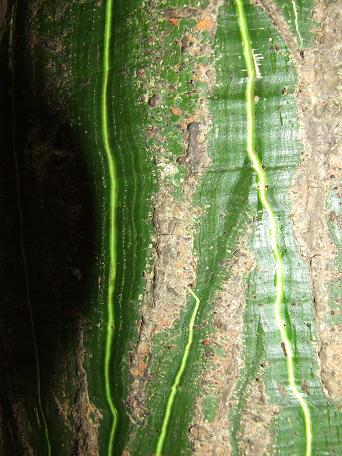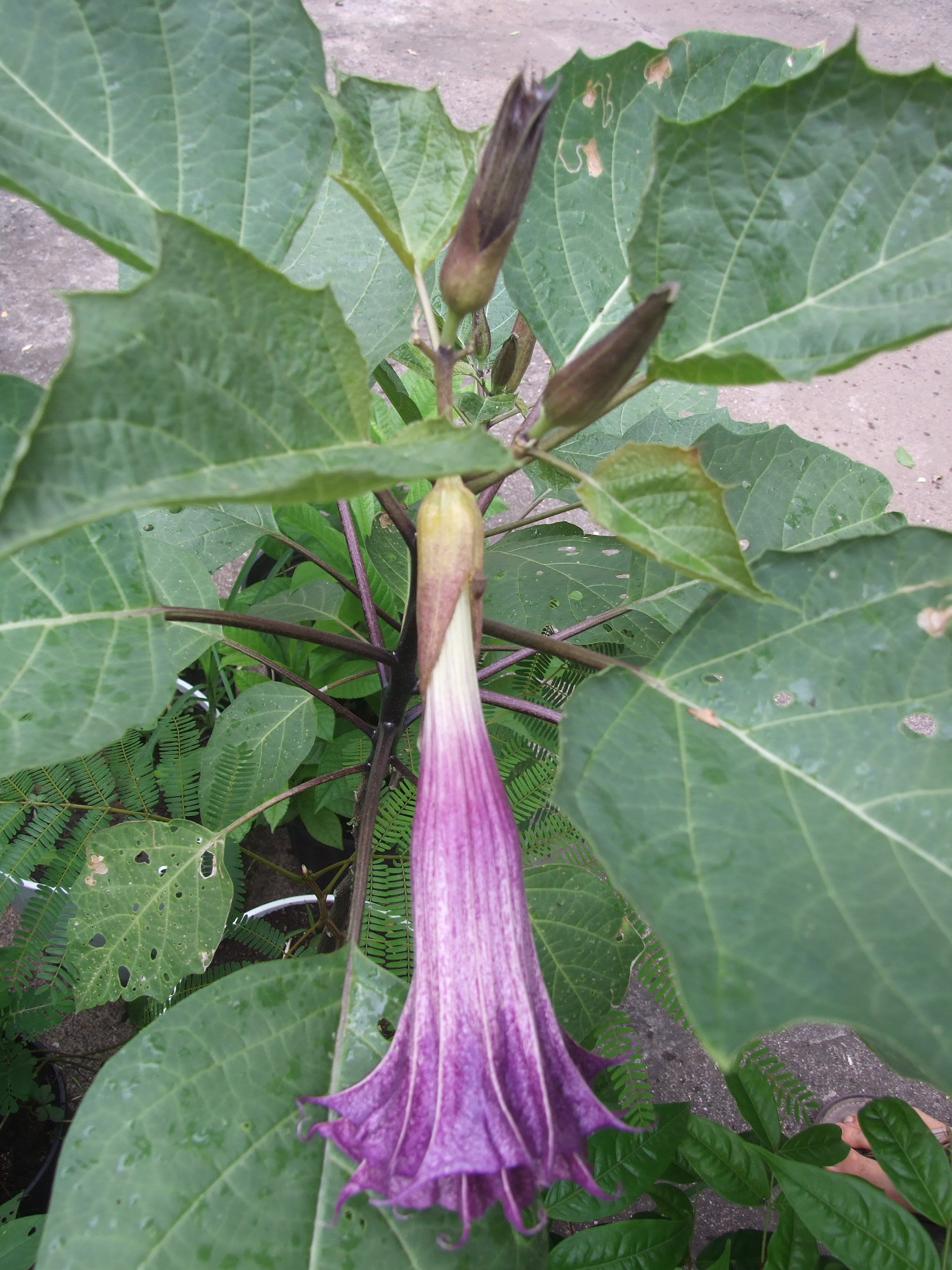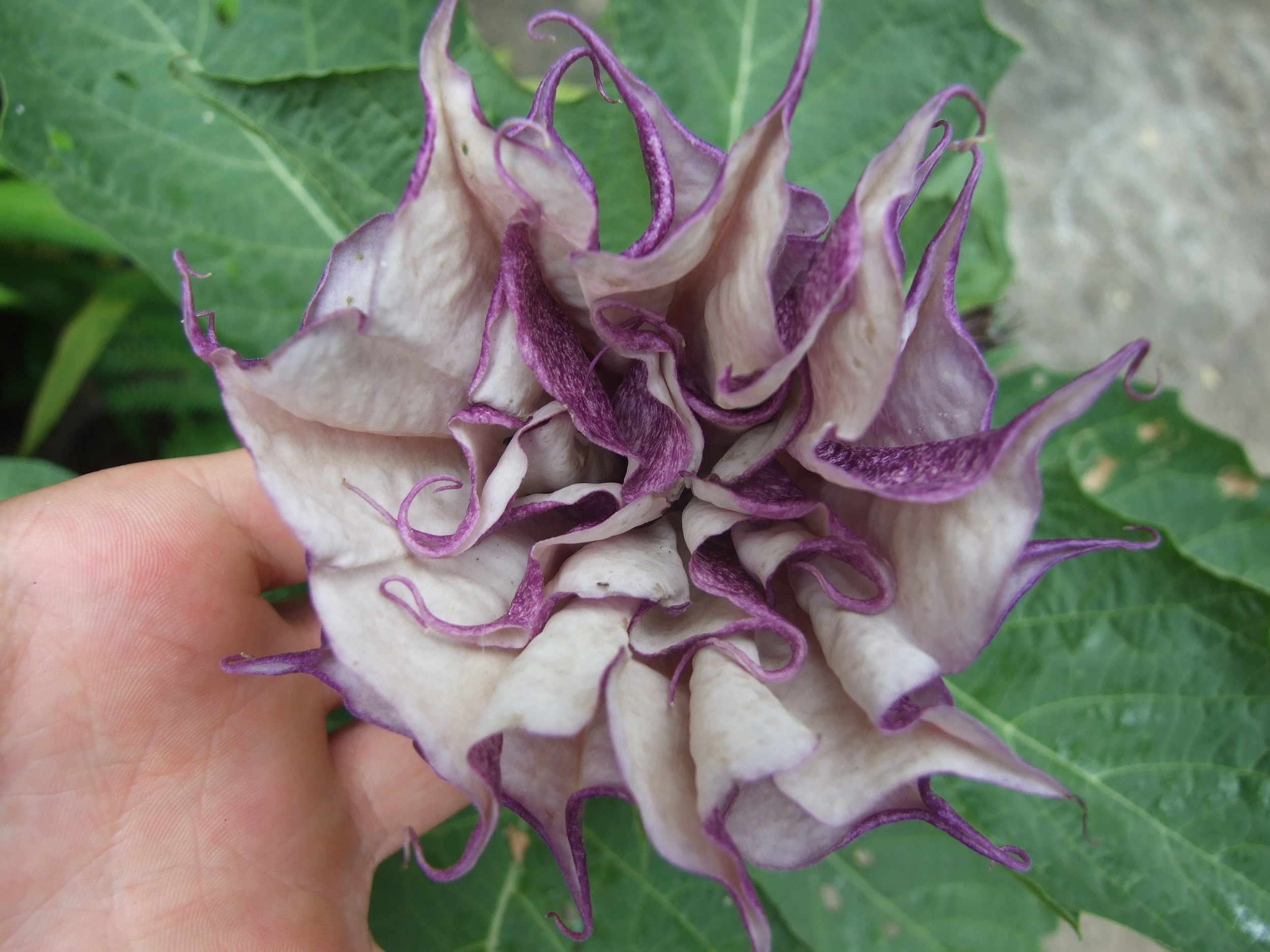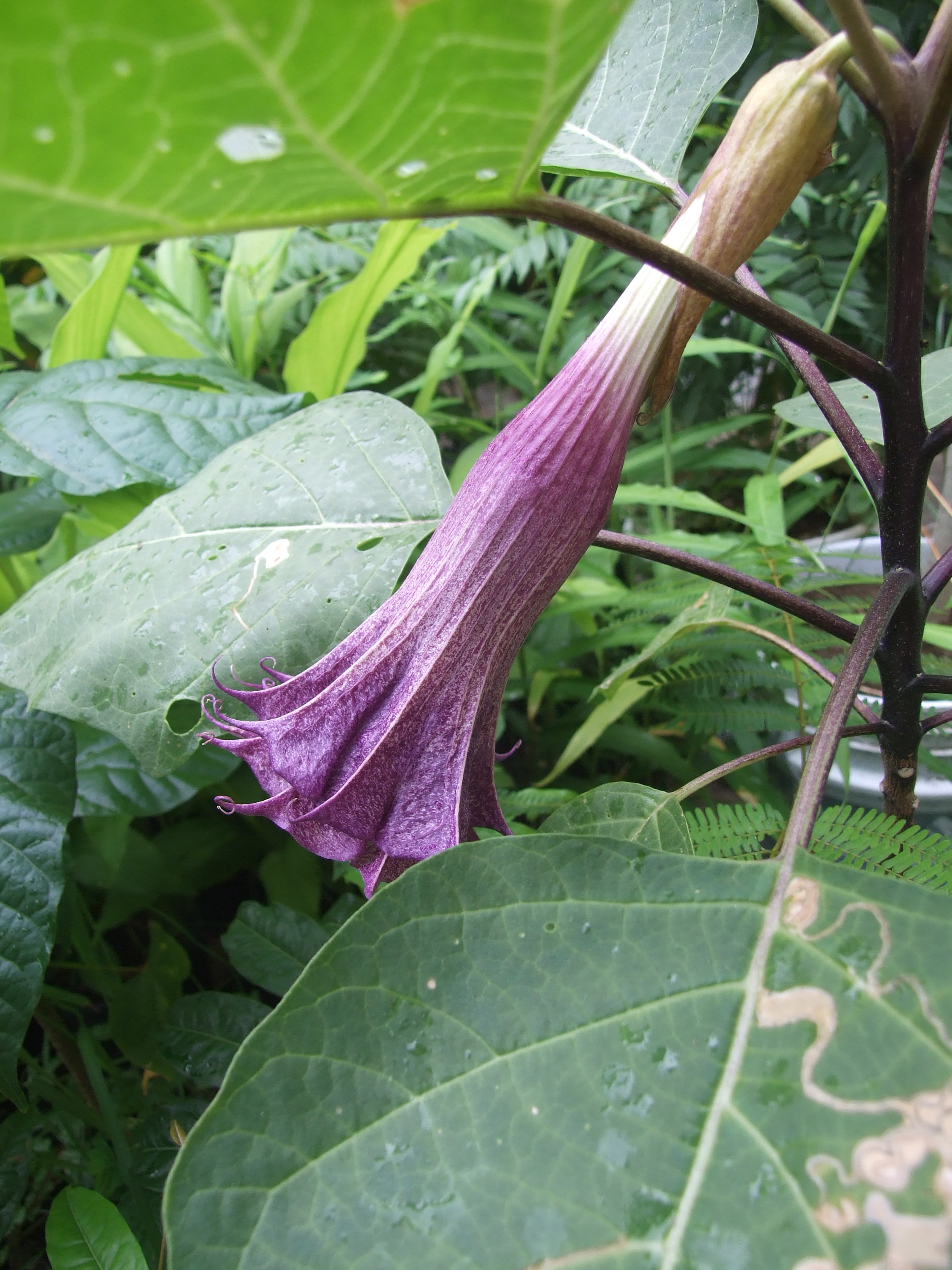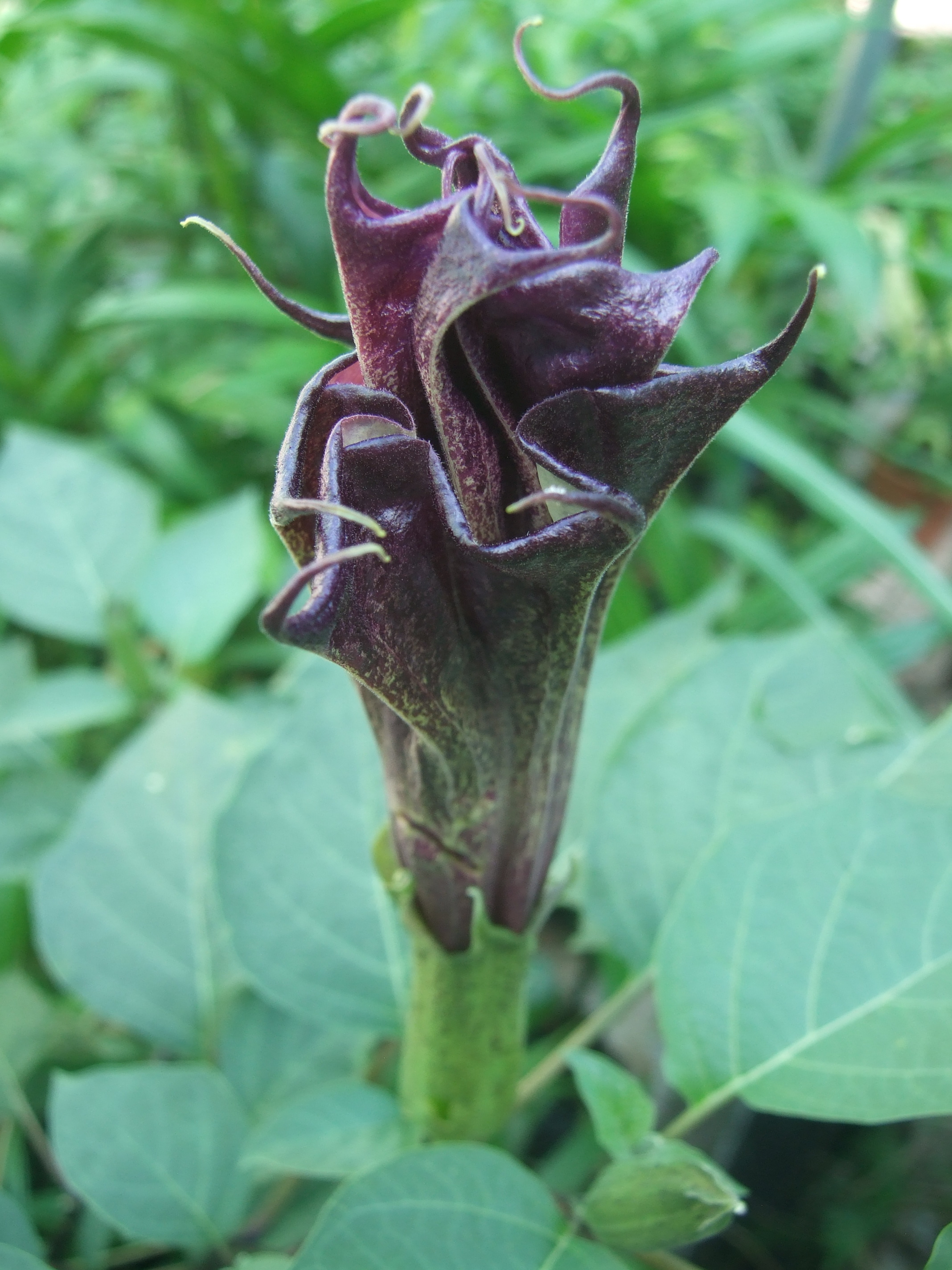Here's a link to a post with more information and photos on Datura metel. And see article below
The Genus Datura: From Research Subject to Powerful Hallucinogen
By Kirsten Bonde
Datura is one of the most interesting plants with hallucinogenic properties. Despite having a reputation as one of the 'darker' hallucinogens, it has been widely used by societies historically in both the Old World and the New, and continues to be today. For those interested in ethnobotanical uses of this plant world-wide, Datura is a fascinating topic. While being limited in its uses economically, the alkaloids contained in the plant have been in demand in the past and its application as a subject for botanical research is vast. Heiser has stated that "Datura is a genus of contrasts - from smelly weeds to lovely ornamentals." This paper will attempt to provide an overview of this varied genus, with specific attention being given to Datura stramonium, most common in North America.
Datura belongs to the family Solanaceae, the nightshades, which Includes some 2,400 species in total (Siegel 1989:36). Other plants with narcotic properties in this family are mandrake (Mandrogora), belladonna (Atropa), henbane (Hyoscyamus), and tobacco (Nicotiana). Appropriately called the "paradoxical plants" by Heiser, this family also includes such common food plants as the tomato, potato, and eggplant (Safford 1922:539). There seems to be some disagreement as to how many sections and species belong to the genus Datura. Conklin (1976:3-4) states that herbaceous Datura is now divided into five sections, while the older citation by Avery (1959:18) claims only four. in any case, this genus contains about ten different herbaceous species, the most important ones being D. stramonium, D. inoxia, D. metel, and D. ceratocaula (Schultes 1979:41-42).
Common names for Datura are numerous, some of the most common ones being raving nightshade, thorn apple, stinkweed, Devil's apple, Jimson weed, and angel's trumpet (Heiser 1969:140 and Avery 1959:19). Datura can be found throughout Asia, Europe, and the Americas as either native or adventive plants, and some have also been found in Africa and Australia (Conklin 1976:5). The epicenter of diversity of this plant is in the New World, specifically in Andean South America and in the southwestern United States/Mexico region (Lewis 1977:423-4). This data correlates with the generally agreed upon origin of Datura, although this topic was debated for some time. Researchers now believe the plant originated and evolved in Mexico and the American Southwest, followed by adaptive radiation into new desert environments (Conklin 1976:5).
Today, Datura (mainly the species stramonium) can be found all over North America as a roadside weed, but never in mountainous or forested habitats (Hutchens 1991:166). A possible explanation for its success as a weed has been offered by Heiser, who argues that the long duration of the seeds is responsible. Tests have shown that Datura seeds stored for 39 years still had a germination rate of 90% (Heiser 1969:140). The plant seems to prefer xeric environments and has an annual or short-lived perennial life cycle (Conklin 1976:5). Since Datura is not a widely grown crop plant, estimations on yield were difficult to locate. The only mention on the topic was in reference to experiments carried out to determine the effect of manure and other nitrogenous fertilizers on the plant. "In 1911 yields from Datura stramonium were reported as increasing from 23 kg. per 100 square meters, on unmanured land to 33 kg. per 100 square meters on land which had been dunged with farmyard manure" (James 1947:230-231).
The earliest mention of a plant of this genus was by the Arab Avicenna in the 11 th century in an account of Arabian medicinal plants, later translated by Dioscorides. The "nut" of the plant was recognized by early botanists as a fruit of a solanaceous plant, later called Datura metel (Avery 1959:3). The generic name of Datura was first used by Linnaeus in his 1737 publication Hortus Cliffortianus. Objecting to "barbaric" nomenclature, he latinized Dhatura or Dutra into the modem name of Datura (Avery 1959:17). The English herbalist Gerard also made mention of Datura in reference to the plant Greek writer Theocrastus called Hippomanes, thought to drive horses mad. He also believed Datura was responsible for putting the priests of Apollo in ancient Greece into their prophetic state (Schultes 1979:109).
Later historical accounts of Datura include Christoval Acosta's Tractado de las Drogas y Medicinas de las Indias Orientales (1578). He describes the use of Datura in the East Indies as an aphrodisiac and also states that the seeds were highly prized treasures by Hindu enamorades, who ground them into a powder to be added to wine or some other medium. Herbalist Li Shi-Chen, in a work on Chinese medicines entitled Peu ts'ao Kang mu (15 90), explained the origin of the Chinese name for Datura. Man t'o lo h ua is said to be taken from the famous Buddhist sutra "Fa hua ching," which states that when Buddha preaches a sermon from heaven, dew forms on the petals of Datura from raindrops. According to the Taoist tradition though, the name refers to a specific star whose envoy is supposed to carry a Datura flower in one hand (Safford 1922:540). These early accounts of the plant offer valuable insight into its widespread use and rich history. But while Datura continued to.be investigated, the most thorough study was conducted in the early 20th century by Albert F. Blakeslee, who spent most of his career using the plant to conduct groundbreaking research Into plant genetics.
Perhaps the most Important contribution of Datura, at least in sclentIfIc terms, is its use as a research subject to better understand fundamental biological principles (Heiser 1069:141). Datura plants contain 12 pairs of chromosomes normally, but trisomic (2n+1) individuals can be grown which have an extra chromosome in one of their twelve sets. This was discovered by Blakeslee, who went on to identify twelve primary mutants, each with one of the normal chromosomes as an extra, and for many of these, two secondary mutants where the extra chromosome was a reduplicated half of the one of the normal ones (Avery 1959:viii). The Blakeslee himself understood the Implications of his work, as evident when he wrote an article for Smithsonian in 1930 and stated, "...it is our belief that in the future extra chromosomes will be consciously utilized as a source of desirable variations in plants of economic Importance" (449). How right he was!
Another great accomplishment was the discovery of a haploid in Datura by Blakeslee. "This was the f1rst haploid to be found in vascular plants and created something of a sensation. Haploid plants, one thought, should be gamophytes, but here was a little plant, rather weak and nearly sterile, that was clearly a sporophyte, but that had only one set of chromosomes in its cells" (Avery 1959.-Vili). With this research, much interest in polyploidy was aroused and investigations continued.
While a total of six stages in the polyploidy series of Datura have now been Identified (1n, 2n, 3n, 4n, 6n, and 8n), the Initial work by Blakeslee was of vast importance. With the finding of polyploids containing four sets of chromosomes Instead of two "was born the concept of genic balance; that is, an organism that has complete extra sets of all of its genes is not very different from a normal organism of its type, whereas an organism that has a single extra chromosome, giving it an extra 'dose' of the genes carried on this chromosome and thus changing the ratio of these genes to those bome on the other chromosomes, has a profoundly changed appearance" (Heiser 1969:142). The research conducted by Blakeslee during his lifetime were of immeasurable value to such diverse aspects of botany as genetics, cytology, physiology, morphology, and anatomy. in the process of this, the Datura plant itself has become better understood. The numerous variations genetically in the plant has amazed many researchers and it is believed that "Datura now probably displays a larger number of distinguishable types due to gene mutations than any other species of plants except corn" (Avery 1959:110).
Being a known hallucinogen, the chemistry and alkaloid composition of Datura also becomes important if one is to understand the plant itself as well as its history. The main alkaloids of medicinal value in Datura are members of the tropane class, namely atropine, hyoscyamine, and hyoscine (Avery 1959:48). All are commonly grouped under the headings of stramonine or daturine (Heiser 1969:141), and are present in varying concentrations in all parts of the plant. The variance is due to the stage of development of the plant and the environmental conditions it is grown in. There is a decreases in the concentration during the day and an increase at night, as well as less following a rainy period than after clear weather (Lewis 1977:419). The effect of environmental factors has been shown to cause as much variation as that found between specific races (Avery 1959:48).
The medicinal value of the alkaloids themselves is significant, but Datura is not considered the best source for them. Atropine is present in small amounts in Datura and can be extracted from hyoscyarnine in a commercial process. The alkaloid has a paralyzing action that helps relieve bronchial spasms in the treatment of asthma. Old-fashioned methods of treating this respiratory problem included use of an inhaler containing stramonine and belladonna (also a primary source of atropine). When the supply of belladonna was cut off during World War II, the United States began intentional cultivation of D. stramonium as a domestic source of atropine. This was abandoned later because imported belladonna was cheaper than domestic Datura resources (Heiser 1969:141).
The daturine alkaloids are also known to cause dilation of the pupil of the eye (mydriasis) and paralysis of the muscles of accommodation (cycloplegia). They effect the nervous system too, with atropine acting as a stimulant and hyoscine as a depressant. Atropine is used to counteract the depression associated with morphine and hyoscine acts as an antidote to highly toxic phosphate insecticides and so called "nerve gases." Other applications of hyoscine Include prevention of motion sickness, as an analgesic along with morphine in obstetrics to produce "twilight sleep," and as a truth drug (Avery 1959:51).
While people may not have been aware of the chemical constituency of Datura, the plant was used medicinally all over the world in historical times. in the Old World, the Chinese used Datura to treat colds and nervous conditions (Siegel 1989:21). in India, the powdered seeds were mixed with butter and taken internally for impotence as well as being applied to genitalia to obtain sexual vigor (Lewis 1977:330). Referred to as the tuft of Shiva, the god of destruction, Datura was also used in the form of a liquid extract by thugs - worshipers of Kali, the goddess of fertility and death - to stupefy sacrificial victims. The plant was also given to young girls in India to bring them Into prostitution as well as on their clients (Siegel 1989:21). The leaves were smoked as well in that country to relieve asthma (Lewis 1977:395).
European usage of Datura can be traced back to pagan rituals. The Church suppressed knowledge of the plant during the medieval witch-burning period and associated Datura and other plants such as deadly nightshade and monkshood with the Devil. "...flying ointments and magical salves were compounded out of Datura roots and seeds, parts of the plant rich in delirium- and delusion-producing tropane alkaloids. When this material was applied to the witch's body, it produced states of extraordinary derangement and delusion" (McKenna 1992:90). The use of broomsticks by witches can be explained by these practices, serving to apply the salves to sensitive vaginal membranes (Lewis 1977:420).
Experiments on these controversial religious practices were carried out by Andres Laguna, a physician to Pope Julius III, and showed how the salves containing Datura took the women on "Journeys" by producing dreams only, contrary to widely-held folk beliefs of the period. Giovanni Battista Porta, a colleague of Galileo and who also took part in Laguna's experiment, described how men drank potions of Datura to create the illusion of being a bird or beast. The men wore wolfs skin and ran about on all fours following ingestion of the hallucinogen, providing the basis of our modem werewolf stories (Siegel 1989:22).
While Datura was definitely used in the Old World, no where did it have as much application as in the New World. The seeds were used by ancient Peruvians in trepanning operations as an anesthetic and archeological evidence Indicates that these complex surgical procedures had a higher survival rate than one would expect (Heiser 1969:136). The use of enema syringes in Peru dates back to 600800 AD and could have contained Datura among other things, considering the vast herbal knowledge of the healers of this region (McKenna 1992:197-8). Wild and cultivated species of Datura were also used in other parts of western South America by indigenous peoples to Induce partial intoxication, to control unruly children, and the plant was given in large doses along with tobacco to women and slaves to deaden their senses before being buried alive with their dead husbands or masters. Extracts made from the bark, leaves, and seeds were also used in shamanistic rites and practices of this region (Avery 1959:4).
The Aztecs also made use of Datura, specifically D. meteloides, which they called ololluhqui "the magic plant," for all kinds of diseases including paralysis and as an ointment for cuts or wounds (Safford 1922:550). The plant's narcotic effects were employed by Aztecan shamans and priests to communicate with spirits, causing visions and stimulating people to dance, laugh, weep, sleep, or tell oracular prophecies. The seeds were considered sacred and kept on altars or in secret boxes and sacrificial offerings made to them by the Aztecs (Avery 1959:4).
Zuni Indians and other cultures in the American Southwest and Mexican region used Datura as well and referred to it as toloache Used to relieve pain during the setting of bones among other things, D. meteloides was the most universally used drug in the region. it was also taken by young boys in male initiation rituals and used in ceremonies following the death of a member of the tribe (Avery 1959:4). Attitudes toward the plant varied among tribes from no special reverence to attribution of supernatural powers. But while knowledge of this plant was widespread among Native Americans, early colonialists were not as aware of Its properties. An interesting example of this is what happened to British soldiers in 1676 sent to Jamestown, Virginia to quell Bacon's Rebellion. After including Datura stramonium in a salad, the soldiers were reported to have gone mad for eleven or so days before the effects finally wore off. This incident is probably the source for Datura's common name jimsonweed, a shortened version of James Town weed (Avery 1959:5).
From an anthropological perspective, the use of Datura stramonium by Algonquin Indians of Virginia in their huskanawing ceremony provides an excellent example, of the role of hallucinogens during the liminal period in rites of passage. The concept of liminality was first discussed by Arnold Van Gennep in his Rites o Passaga (1908) and later elaborated on by Victor Turner. The liminal period is one part of rites of passage during which initiates are removed from social space and involved in reflection and learning about their particular society. Victor Turner has pointed to the Importance of studying this phenomenon in order to understand processes of social change generationally within a culture. The use of Datura in this rite provides such insight.
Beverly in his History of Virginia (1705) described the rite of huskanawing. The rite was practiced by Algonquins every fourteen or sixteen years and involved taking the "choicest and briskest" young men of the society into the woods and ritually administering an intoxicating medicine (wysoccan), containing Datura, to them. The rite was necessary if the young men hoped to become great men or officers within their society. Kept in cages or enclosures for several months, the local medicine men carefully fed the boys only wysoccan, causing them to become "stark, raving mad" for a period of eighteen or twenty days so as to "perfectly lose the remembrance of all former things, even of their parents, their treasure, and their language." When sufficient dosages had been administered, the amount was reduced gradually and the young men slowly returned to their senses. But before the potion completely wore off, the boys were brought back, into their village and carefully observed to see if any memories of their former life as boys were discovered. If one did show signs of remembering, the entire ritual had to be undergone again, this time greatly endangering the life of the initiate (Safford 1922:558-9).
While this may serve as a severe example of liminality, the purpose of the rite being one of transition follows Van Gennep's and Turner's theory perfectly. As Beverly describes, the boys are forced to relearn all aspects of their culture, "...thus they unlive their former lives, and commence men by forgetting that they ever have been boys" (Safford 1922:558-9). In order to become fully adult, socialized members of Algonquin society, the boys must leave their former role of boyhood and its accompanying memories behind. While possible reasons for the severity of the ritual are beyond the scope of this paper, the account by Beverly struck me as Important enough to Include and is worth further research in the future.
While the above descriptions make it appear like Datura is a fairly widely used, relatively harmless hallucinogenic plant, this is not at all the case. There is adequate reason for Datura's dark -reputation and probably one of the more famous examples has to do with Abraham Lincoln's mother, Nancy Hanks. She apparently drank milk from a local cow that had grazed on the plant and consequently developed "milk sickness," a slow but fatal disease. Her death effected Lincoln tremendously and caused the President to remain abstinent from alcohol for the remainder of his life (Siegel 1989:259). The possibility of poisoning when taking Datura is fairly high and occurs often with symptoms similar to belladonna. As discussed earlier, chemical composition of the plant varies with environmental conditions the plant is grown In, thereby making it difficult to determine a safe dosage. Cases of children eating parts of the plant have often been reported, attracted by the colorful flowers and seedpods. Livestock poisoning seems to be rarer, possible due to Datura's odor and taste (Lewis 1977:54).
With its long history of human usage, one may ask how people learned to use Datura safely. One possible answer lies in the foraging habits of animals. Tribal peoples, living in a much closer relationship with nature, probably observed the effects Datura had on different species of animals and copied their eating strategies when consuming the hallucinogen themselves. Modern scientists have watched hawk moths feed on the flowers at night and become disoriented. Nonetheless, the moths continue to attempt to return to the plant for further feeding. Hummingbirds also favor Datura and after ingesting the narcotic perch, fluff their feathers, and then freeze stiff like corpses for several hours (Siegel 1989:25). Other research has also demonstrated that animals chose to eat hallucinogenic plants on an infrequent basis only, seeming to realize that tolerances can easily develop with regular usage.
Interestingly, some animals are unaffected by Datura Beetles have developed biochemical defenses against the plants potent chemicals and ants appear to have done the same, often being observed carrying away the seeds. Bees are unaffected as well and various species of birds are known to eat the seeds, thereby acting as a dispersal mechanism for the plant (Siegel 1989:24). Using animals as a model to learn from, ancient hunters and gatherers probably began using Datura and many incorporated it into shamanistic rituals, a more controlled environment for ingestion of such a powerful and dangerous hallucinogen.
The uses of this plant historically have been numerous, but we can also benefit from Datura in the future. Detoxification of the environment used to be taken care of by nature back when human beings lived in a more harmonious relationship with the earth. With increasing amounts of pollution resulting from modernization and industrialization, cleaning up the mess becomes a Larger challenge every day. The Datura plant can aid in these efforts. "The shrub Datura stramonium can act like a toxin sponge, leaching heavy-metal elements from polluted soils. The toxins are concentrated in its tissue, which can then be removed" (McKenna 1989:8). When discovering this Information, I was further Impressed with the belief that only by becoming more in touch with plants and nature can we hope to sustain as a species in the future. By ignoring the knowledge plants such as Datura can offer, we miss the very means by which to insure our own survival.
Literature Cited
Avery, Amos G., S. Satina, and J. Rietsema. Blakeslee: The Genus Datura. New York: Ronald Press Co., 1959.
Blakeslee, Albert F. "Extra Chromosomes, A Source of Variations in the Jimson Weed." Annual Report of the Board of Regents o the Smithsonian institution 1930. Washington: US Government Printing Office, 1931.
Conklin, Marie E "Genetic and Biochemical Aspects of the Development of Datura" Monographs in Developmental Biology. New York: Karger, 1976.
Heiser, Charles B. Jr. Nightshades., The Paradoxical Plants. San Francisco: WH Freeman and Co., 1969.
Hutchens, Alma R. Indian Herbalogy of North America. Boston: Shambala, 1991.
James, G.M. "Effects of Manuring on Growth and Alkaloid Content of Medicinal Plants." Economic Botany 2 (1947): 230-237.
Lewis, Walter H. and M.P.F. Elvin-Lewis. Medical Botany: Plants
Effecting Man's Health. New York: John Wiley and Sons, 1977.
McKenna, Terence. Food of the Gods: The Search for the Original Tree of Knowledge. New York: Bantam Books, 1992.
McKenna, Terence. "Plan, Plant, Planet." Whole Earth Review (64) Fall 1989.
Safford, William E. "Daturas of the Old World and New: An Account of their Narcotic Properties and their Use in Oracular and Initiatory Ceremonies." Annual Report of the Board of Regents of the Smithsonian Institution 1920. Washington: Government Printing Office, 1922.
Schultes, Richard E. and Albert Hoffman. Plants of the Gods. New York: McGraw-Hill, 1979.
Siegel, Ronald K. Intoxication: Life in Pursuit of Artificial Paradise. New York: EP Dutton, 1989.
This document Copyright Kirsten Bonde
